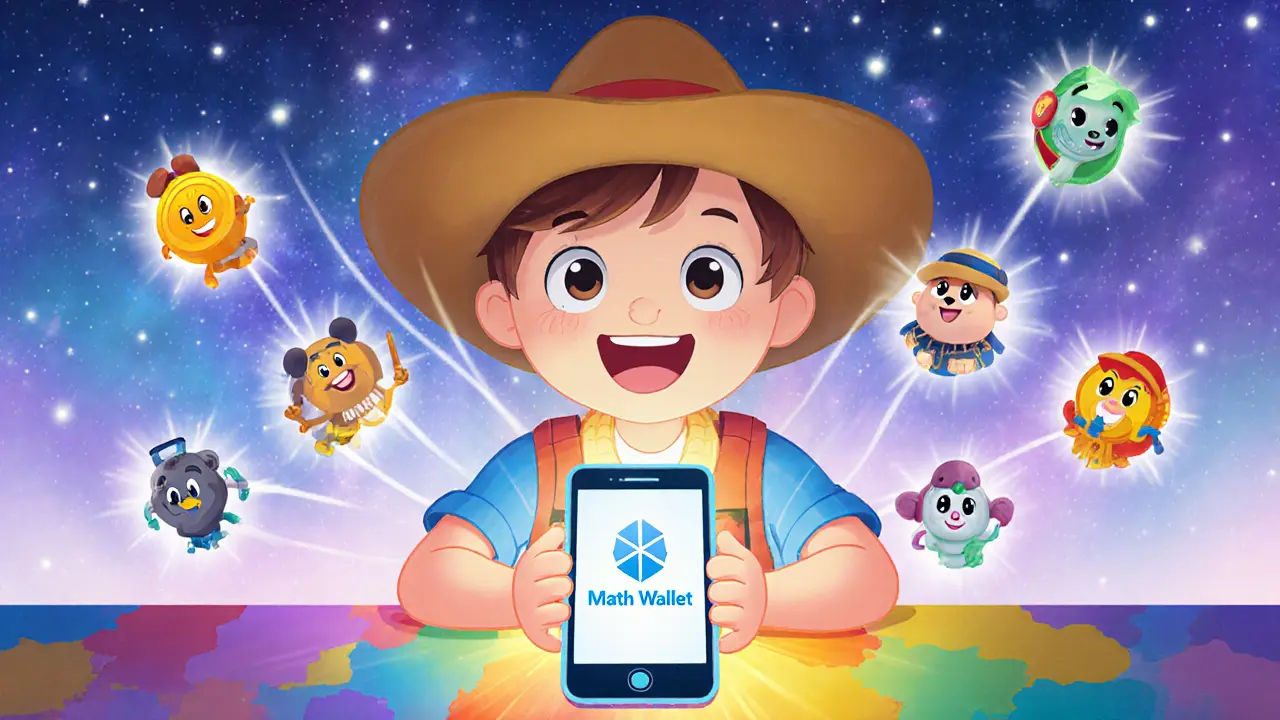MATH Token Value Calculator
MATH Token Overview
The MATH token powers the entire Math ecosystem, enabling staking, transactions, and access to premium features.
Token Supply
Maximum Supply
Current Price Range
24-hour Trading Range
Calculate Your MATH Holdings Value
Enter your MATH holdings to see their current value and potential staking returns.
Results
Current Value: $0.00
Annual Return (Staking): $0.00
Monthly Return (Staking): $0.00
Estimated 1-Year Return: $0.00
Key MATH Features
- Multi-chain wallet supporting 63+ networks
- VPOS staking with up to 30% APR
- Built-in DApp browser and trading tools
- Algorithmic trading with MathSwap
- Second-layer blockchain (MathChain) for faster transactions
If you’ve been scrolling through crypto forums and keep spotting the ticker MATH crypto, you’re probably wondering what it actually does. In short, MATH is both a token and an entire ecosystem built to let users manage assets across dozens of blockchains from a single interface, stake for high yields, and trade automatically. This guide breaks down the platform’s history, core services, token economics, and why it matters in today’s multi‑chain world.
What Is the MATH Ecosystem?
MATH is a comprehensive cryptocurrency platform launched in 2018. It functions as a one‑stop shop for wallet management, staking, decentralized applications (DApps), and algorithmic trading. The ecosystem supports more than 63 public blockchains, making it one of the most expansive multi‑chain solutions available.
Core Components of the Platform
At the heart of the ecosystem are several interconnected services. Below is a quick rundown of each major piece.
| Component | Primary Function | Notable Feature |
|---|---|---|
| Math Wallet | Multi‑chain wallet extension and mobile app | Supports 63+ networks, DApp browser built‑in |
| MATH VPOS Pool | Staking service offering validator‑as‑a‑service | APR up to 30% on supported assets |
| Math DApp Store | Curated marketplace for decentralized apps | Includes MathSwap, Uniswap, SushiSwap, Polkadot tools |
| MathChain | Second‑layer blockchain built on Substrate | Higher throughput, lower fees than main nets |
| MathSwap | Automated token exchange with quantitative strategies | Algo‑driven portfolio rebalancing |
The MATH Token: How It Works
The native token, introduced in 2019 as an ERC‑20 asset, powers every service in the ecosystem. Its main roles are:
- Staking collateral for the VPOS pool and validator nodes.
- Payment for transaction fees on MathChain and within the wallet.
- Reward distribution for users who provide liquidity or run DApps.
Supply metrics (as of October2025):
| Maximum supply | 200,000,000 MATH |
| Circulating supply | ≈185,000,000 MATH |
| All‑time high price | $3.15 (20Mar2021) |
| All‑time low price | $0.06 (9Nov2022) |

Staking with the VPOS Pool
Staking is the most advertised feature of MATH. Users deposit MATH or supported assets into the VPOS pool, and the platform allocates these funds to validator nodes across multiple blockchains. In return, participants earn a share of block rewards plus platform‑generated incentives.
- Open Math Wallet and navigate to the ‘Staking’ tab.
- Select the asset you wish to stake (MATH, DOT, Near, etc.).
- Enter the amount and confirm the transaction. Funds are locked for a minimum of 7days.
- Monitor earnings in real‑time; APR can reach 30% for high‑yield pools.
Key considerations:
- Higher APR usually means the pool is newer or has lower total stake, which can increase volatility.
- Unstaking before the lock‑up period incurs a penalty, typically 0.5‑1% of the withdrawn amount.
Multi‑Chain Interoperability
What sets MATH apart is its breadth of network integrations. The wallet can store and transact on major chains like Ethereum, BNB Smart Chain, Polkadot, Near, Avalanche, and dozens of lesser‑known networks. This is achieved through a modular bridge architecture that abstracts each chain’s RPC and signing methods into a unified API.
Benefits for users include:
- One password, one seed phrase for all assets.
- Direct DApp access without switching wallets.
- Cross‑chain swaps via built‑in MathSwap.
Market Position & Competition
In the crowded wallet‑and‑DeFi space, MATH competes with heavyweights like MetaMask, Trust Wallet, and newer cross‑chain hubs such as Rainbow and SafePal. Its competitive edge is the sheer number of supported chains and the bundled staking/automated‑trading suite. However, brand recognition lags behind; MATH sits outside the top1,000 cryptocurrencies by market cap, which can affect liquidity and exchange listings.
Strengths:
- 63+ blockchains, more than most rivals.
- Integrated VPOS staking with double‑digit APR.
- Algorithmic trading tools for passive investors.
Weaknesses:
- Complex UI for beginners; many features hidden behind sub‑menus.
- Limited public roadmap - users often have to wait for community updates.
- Trading volume modest compared with top DeFi platforms.

Getting Started: A Quick Checklist
- Visit mathchain.org and download the Math Wallet extension (Chrome, Firefox) or mobile app.
- Create a new wallet - write down the 12‑word seed phrase offline.
- Fund the wallet with any supported token (e.g., ETH, BNB, or MATH).
- Explore the DApp Store; try a test swap on MathSwap to see the algorithmic trading UI.
- If you want passive income, navigate to the VPOS pool, select an asset, and stake the desired amount.
- Enable two‑factor authentication in the settings for extra security.
Remember to keep your seed phrase secure and never share it, even with “support” channels.
Risks & Mitigations
Like any crypto project, MATH carries typical market risks (price volatility, regulatory changes) plus platform‑specific concerns:
- Smart‑contract bugs: The VPOS pool and MathSwap contracts are audited, but bugs can still emerge. Mitigate by staking only amounts you can afford to lose.
- Interoperability failures: Bridge outages can temporarily block transfers. Keep a small reserve on a native wallet as a fallback.
- Liquidity constraints: Lower trading volume may lead to slippage on larger swaps. Split large orders across multiple DApps or use limit orders where available.
Future Outlook
The broader crypto industry is moving toward cross‑chain solutions, with projects like Polkadot and Cosmos driving the narrative. MATH’s strategy-building a unified UI on top of a Substrate‑based second layer-aligns well with that trend. Ongoing development activity on GitHub suggests the team is adding new chain integrations monthly, but a public roadmap is still sparse. Investors should watch for announcements around MathChain upgrades, new staking partners, and expanded DApp partnerships as key catalysts.
Frequently Asked Questions
What is the primary purpose of the MATH token?
MATH serves as the utility token for the entire Math ecosystem. It is used for staking, paying transaction fees on MathChain, rewarding liquidity providers, and accessing premium features in the DApp Store.
How many blockchains does Math Wallet support?
More than 63 public blockchains are integrated, ranging from Ethereum and BNB Smart Chain to Polkadot, Near, Avalanche, and many niche Layer‑2 solutions.
Can I stake assets other than MATH?
Yes. The VPOS pool accepts several mainstream tokens such as DOT, Near, and Binance‑staked BNB. Each asset has its own APR curve.
Is MathSwap safe for automated trading?
MathSwap runs on audited smart contracts and uses quantitative algorithms to rebalance portfolios. While the code is open‑source, users should start with small amounts to verify performance.
Where can I buy MATH?
MATH is listed on about a dozen exchanges, including Coinbase Pro, Gate.io, MXC, and BitMart. You can trade the MATH/USDT pair for the best liquidity.






Franceska Willis
Whoa, you just dropped a massive info dump on MATH and didn’t even tell us why anyone should care about another token! The guide looks slick, but I’m still wondering if the staking APRs are legit or just hype.
Melanie LeBlanc
Honestly, the ecosystem’s breadth is impressive-63+ chains is no joke. If you can actually manage all those assets from one wallet without a nightmare UI, it could be a real game‑changer for multi‑chain users.
EDWARD SAKTI PUTRA
I appreciate the thorough breakdown; the VPOS staking mechanism seems solid, especially with the audited contracts. It’s good to see the risk mitigations spelled out clearly.
Mark Fewster
Indeed, the audit aspect is crucial; however, users should still keep a modest amount in the pool until the platform proves consistent performance over several months.
Richard Bocchinfuso
Look, you can’t just push this token as the next big thing without admitting it’s still a niche player. The liquidity is low, the price is stuck around a dime, and most folks don’t even know it exists.
Don Price
First off, the whole multi‑chain narrative is a smokescreen engineered by the “elite” crypto cabal to distract us from the fact that they’re pumping MATH while quietly siphoning off fees through hidden layers. They claim 30% APR is a sweet deal, but anyone who’s looked at the underlying validator economics knows that such yields are unsustainable without massive token inflation. The math behind “algorithmic trading” on MathSwap is basically a glorified arbitrage bot that can be gamed by insiders who have privileged access to off‑chain data. Meanwhile, the supposed “second‑layer MathChain” is just a Substrate fork that adds another point of failure; every additional layer is another vector for a backdoor. Their audit reports are glossy PDFs, yet they omit any discussion of the bridge contracts, which have historically been the Achilles’ heel of cross‑chain projects. It’s also worth noting that the token’s market cap barely cracks the top‑1,000, meaning it’s extremely illiquid, and any large sell‑off would crush the price. The community forum is riddled with bots pushing “buy‑the‑dip” posts, which is classic pump‑and‑dump behavior. Even the purported “DApp store” is populated with copy‑pasted projects that haven’t been vetted thoroughly. You’ll also find that the staking lock‑up penalties are variable, so the “7‑day lock” could be extended arbitrarily if the network decides to upgrade. Additionally, the wallet’s UI is intentionally convoluted; they want novices to fumble and call support, opening the door for social engineering scams. All of these red flags point to a coordinated effort to inflate the token’s perceived utility while the real value remains stagnant. If you’re not willing to accept a high‑risk background, you should steer clear of MATH and allocate capital to more transparent, higher‑volume assets.
Dawn van der Helm
Great overview! 😊 The multi‑chain support really stands out, and the staking rewards look tempting for passive earners.
Monafo Janssen
Exactly, and the fact that you can stake assets beyond MATH, like DOT or Near, adds flexibility. It’s a solid option for diversifying yields without juggling multiple wallets.
Michael Phillips
The philosophical angle of unifying disparate blockchains under a single interface aligns with the broader vision of decentralization becoming truly interoperable. From an academic standpoint, MathChain’s substrate foundation is commendable, yet practical adoption will hinge on developer incentives.
Jason Duke
Agreed! The platform’s ambition is massive-however, until more exchanges list MATH and trading volume spikes, the utility remains mostly theoretical. It’s a wait‑and‑see game, but the roadmap looks promising!
Bryan Alexander
Honestly, the guide makes MATH feel like the Swiss Army knife of crypto-if it lives up to the hype, we could see a surge in multi‑chain activity.
Patrick Gullion
True, but let’s not ignore the fact that many projects claim “one‑stop‑shop” and fail to deliver. It’s worth keeping a skeptical eye while testing the wallet with small amounts.